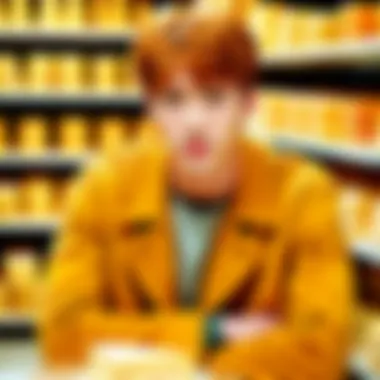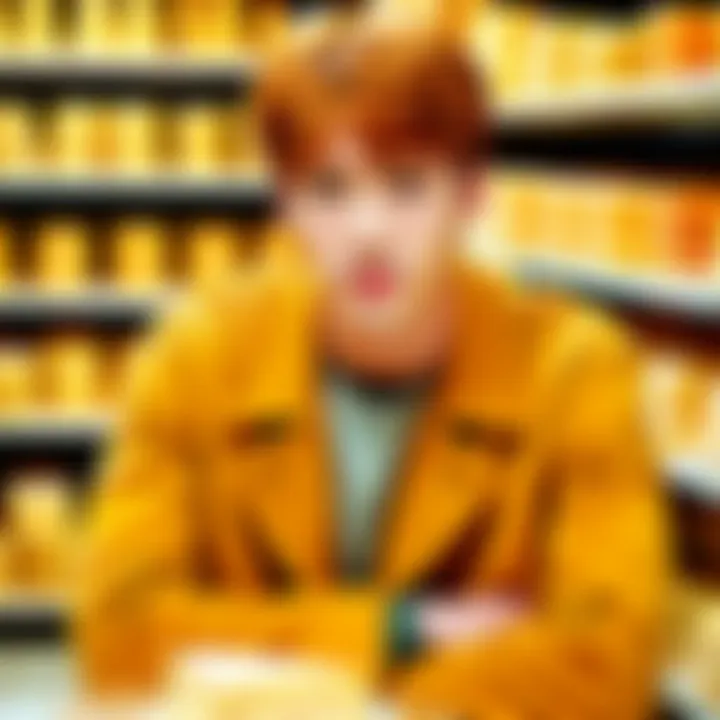Exploring the Depths of Cheese in the Trap


Intro
In the vast landscape of webtoons, Cheese in the Trap has carved out a distinct niche. This series presents not just an engaging storyline but also provocative themes and intricate character development. As it explores the lives of university students navigating relationships and personal growth, it reflects broader socio-cultural themes relevant to modern society.
Understanding the layers of this narrative requires a meticulous analysis of its many components. Through the exploration of its primary storyline, character arcs, and overarching motifs, readers can gain insight into the nuances that make Cheese in the Trap a significant piece of contemporary storytelling.
Series Overview
Synopsis and Premise
Cheese in the Trap unfolds the complex interactions among its main characters at university. The lead, Hong Seol, is an intelligent but introverted student. She becomes entangled with the enigmatic Yoo Jung, whose charm masks deeper issues. This relationship serves as the core, driving the emotional narrative forward. The webtoon examines the nuances of connection, misunderstandings, and evolving perceptions in relationships.
The premise revolves around everyday experiences interspersed with moments of tension and introspection. As the plot develops, the characters face dilemmas that resonate with the reader’s own experiences, enhancing its relatability.
Notable Characters
The character design and development in Cheese in the Trap are pivotal in attracting and maintaining reader interest. Three main figures stand out:
- Hong Seol: She is portrayed as a resilient character who confronts various challenges both academically and emotionally. Her growth is a central focus in the narrative.
- Yoo Jung: A complex character, he embodies both charm and mystery. His actions often create confusion for Seol, driving the plot's tension. This duality makes him compelling.
- Baek In-ho: A significant supporting character, he represents the reckless side of youth living with burdens and expectations. His interactions with Seol and Jung deepen the narrative.
These characters navigate themes such as trust, loneliness, and identity, contributing to the overall richness of the narrative.
Themes and Motifs
Major Themes Explored
Cheese in the Trap delves into several central themes:
- Youth and Identity: The story explores the search for self amidst external pressures. Characters often grapple with their identities.
- Trust and Betrayal: Relationships evolve under scrutiny. Trust becomes a fragile construct, leading to moments of betrayal that alter dynamics.
- Social Commentary: The series highlights societal expectations and the struggles young adults face in professional and personal spheres.
These themes resonate widely, connecting with many readers' experiences post-adolescence.
Symbolism in Storytelling
Symbolism plays a key role in enriching the narrative. Objects and recurring visual motifs serve as representations of larger concepts.
For example, food acts as a comfort yet can symbolize deeper emotional states. The cheese motif itself represents both nourishment and the complexities within social interactions, illustrating the series' depth.
Artistic Style and Animation
Visual Aesthetics and Design
The visual representation of Cheese in the Trap is marked by detailed character expressions and settings that reflect emotional tones. The art style balances realism with stylistic choices that accentuate pivotal moments, guiding the audience through emotional arcs.
Animation Techniques and Trends
Though primarily a webtoon, its adaptation into animated forms has introduced dynamic techniques, blending traditional animation with digital enhancements, creating fluid storytelling that maintains the original narrative's depth.
This artistry contributes significantly to the series’ appeal, making it a visual delight alongside its narrative complexities.
"Cheese in the Trap exemplifies how character connections shape the reader's understanding of the overarching narrative and themes."
Understanding these elements provides a comprehensive appreciation of what make Cheese in the Trap an essential part of the modern webtoon landscape.
Foreword to Cheese in the Trap
Understanding the layers of storytelling within Cheese in the Trap is crucial for grasping the broader cultural and social implications of this webtoon. This section seeks to establish a foundation for the article by examining how narrative techniques contribute not only to character development but also serve as a reflection of societal norms and challenges in contemporary life. The examination of these layers offers readers insights into the complexity of human relationships and emotional intricacies in a modern setting.
Overview of the Webtoon
Cheese in the Trap, created by Soonkki, has emerged as a significant work in the webtoon genre. It follows the life of Hong Seol, a university student navigating complex relationships with her peers, particularly the enigmatic Yoo Jung. The webtoon is well-regarded for its realistic portrayal of college life, underlined by its engaging plot and character arcs. Each chapter builds upon the last, allowing for a slow unveiling of character motives and emotional struggles.
The narrative structure is unique in that it often blurs the lines between protagonist and antagonist. Yoo Jung's character, in particular, is multifaceted, challenging readers to question their own perceptions of morality and intent. The webtoon showcases a range of themes including manipulation, trust, and self-discovery, engaging the audience in a dialogue about personal and social dynamics.
Cultural Context and Themes


Cheese in the Trap does not exist in a vacuum; it reflects a specific cultural moment in South Korea, where pressures of academic life, social expectations, and emotional well-being are at the forefront. The themes depicted in the webtoon resonate with a generation facing the realities of adulting in an increasingly competitive world.
The relationship dynamics experienced by the characters reveal broader societal issues. For instance, the exploration of manipulation and trust challenges readers to ponder on how these themes manifest in their lives. The realism embedded in the narrative fosters an atmosphere where every action has consequences, making the reader reflect on the implications of their decisions.
"In our age, understanding oneself and others is paramount. Cheese in the Trap serves as a subtle reminder of this truth, weaving a narrative that is both relatable and thought-provoking."
In summation, the analysis of Cheese in the Trap provides valuable insight into its significance, both as a piece of entertainment and as a cultural artifact. The webtoon encapsulates the struggles of youth, offering a profound commentary on interpersonal relationships that mirrors the challenges faced in real life.
Narrative Structure
Narrative structure is a critical element in any form of storytelling, and in the case of 'Cheese in the Trap', it carries specific weight. The way the plot is constructed significantly influences the audience's experience. The organization of events, character developments, and the tension built over time all contribute to the depth of the story. Understanding this structure helps in appreciating how effectively the creators communicate both the emotional and intellectual themes within the webtoon.
Plot Development
Plot development in 'Cheese in the Trap' exemplifies intricate layering. At first glance, it appears to follow a straightforward storyline revolving around university life, romantic interests, and interpersonal conflicts. However, as the narrative unfolds, it becomes evident that the plot is rich with subplots and nuanced character arcs. The protagonist, Hong Seol, faces conflicts stemming from her relationships and the complexities of trust. Each chapter introduces new developments that not only advance the story but also invoke critical thinking about trust and manipulation.
This iterative plot development invites readers to engage deeply with the characters. They find themselves invested in outcomes that are not merely about romantic resolutions but rather about personal growth and ethical dilemmas. Additionally, the pacing of these developments varies, which affects how readers perceive the intentions of the characters.
Pacing and Tension
Pacing in 'Cheese in the Trap' is meticulously crafted, allowing for a build-up that engages readers without overwhelming them. The careful modulation of storyline moments allows for periods of tension to coalesce naturally. For instance, suspenseful moments where secrets are almost revealed contribute to a gripping atmosphere. Here, the tension serves to compel the audience to anticipate outcomes actively. This is essential in a story laden with themes of manipulation, as it keeps questioning the truth behind character motivations.
The calculated pacing not only enhances tension but also encourages reflection on the broader themes at play. Readers are led to contemplate not just the immediate events unfolding but also the underlying moral ambiguities present.
"In a nuanced narrative like 'Cheese in the Trap', plot development and pacing must work in harmony to reveal the emotional intricacies of character relationships."
This interaction between pacing and plot development illustrates the depth of narrative structure in this webtoon. Through its layered approach, 'Cheese in the Trap' achieves a multi-faceted storytelling experience that reinforces its themes and character dynamics.
Character Analysis
Understanding the character analysis in "Cheese in the Trap" is crucial for grasping its narrative depth and overall impact. The characters are intricately woven into the fabric of the story, serving not only as vehicles for plot progression but also as reflections of societal dynamics. Analyzing characters offers insight into their motivations, relationships, and conflicts, which enriches our comprehension of the themes presented within the webtoon.
Protagonist Examination: Hong Seol
Hong Seol stands out as a relatable protagonist in "Cheese in the Trap." She is portrayed as a complex individual balancing her academic life and personal struggles. Her journey is filled with moments of resilience and vulnerability. Seol’s perspective represents a significant voice, showcasing the challenges faced by young adults in a competitive environment.
Seol’s character arc is essential for understanding the broader themes of trust and manipulation throughout the story. Her interactions with Yoo Jung, as well as other supporting characters, reveal her growth and the impact of her decisions. Consequently, readers may find themselves empathizing with her struggles, ultimately leading to a greater connection with the narrative. This relatability contributes to the series’s acclaim and has increased its popularity among fans.
Antagonist Insights: Yoo Jung
Yoo Jung serves as a fascinating antagonist, his character adding layers of complexity to the story. He is not a typical villain; rather, he embodies moral ambiguity. Yoo Jung's charm often masks his manipulative tendencies, creating a duality that keeps readers guessing about his true intentions.
His relationship with Hong Seol is pivotal. Unlike other antagonists, he exhibits moments of genuine care, complicating the reader’s perception of him. Jung's psychological depth invites critiques of societal expectations regarding masculinity and power dynamics. This nuanced portrayal invites discussion about the nature of trust in relationships, ultimately enhancing the narrative’s richness.
Supporting Characters and Their Roles
Supporting characters in "Cheese in the Trap" serve essential functions that amplify the main storyline. Each character represents different aspects of university life and encapsulates various adolescent experiences.
- In-ho: A standout supporting character, he serves as a foil to both Hong Seol and Yoo Jung. His complex feelings and motivations contribute significantly to the subplot, revealing deeper emotional layers.
- Kwon Eun-taek: He represents loyalty and friendship, grounding Seol’s experiences. His presence underscores the importance of support systems during challenging times.
These supporting characters are not mere background figures. Instead, they reflect broader themes, such as loyalty, ambition, and betrayal, enriching the reader’s understanding of the primary narrative. Their interactions with the main characters illuminate their personalities and provide context for their respective arcs.
By examining the character dynamics in "Cheese in the Trap," readers can appreciate the depth of storytelling, laying a foundation for understanding the series as a whole. The characters create a vivid tapestry of interpersonal relationships that significantly contributes to the overall themes of the webtoon.
Artistic Style and Visual Representation
The artistic style and visual representation in ‘Cheese in the Trap’ play a crucial role in conveying the narrative and emotional depth of the story. The webtoon is known for its unique visual identity that significantly enhances character development and plot progression. By focusing on distinct artistic elements, the creators have crafted a world that feels relatable and lends itself to exploring complex themes.
Art Style Evolution
The evolution of the art style in ‘Cheese in the Trap’ mirrors the growth of the characters and their relationships. Early illustrations were relatively simplistic, focusing on clean lines and basic facial expressions. As the story progressed, the artwork evolved to become more detailed and expressive, allowing for a stronger connection to the emotions that the characters experienced.
This progression in art style helps to reflect the changes in tone of the narrative. For example, the artwork becomes darker and more intricate during moments of tension, showcasing the psychological struggles faced by the protagonist, Hong Seol. Conversely, lighter and softer drawings accompany scenes of warmth or happiness, adding layers to the interpretation of both plot and character.
Color Palette and Symbolism
The choice of colors in ‘Cheese in the Trap’ is strategic and meaningful. The color palette shifts to evoke specific emotions and attitudes towards the characters and their circumstances. Lively tones often represent youth and vibrancy, while muted shades may signify introspection or conflict.


Colors are not merely aesthetic; they serve as symbols throughout the webtoon. For instance, warm colors like orange and yellow often appear during scenes of friendship and support, while cooler tones such as blue and grey dominate moments of isolation or tension. This method reinforces the emotional undercurrents in each scene and allows the audience to instinctively grasp the mood conveyed without explicit dialogue.
"Art is not what you see, but what you make others see." – Edgar Degas
Understanding these visual elements enriches the reading experience. Readers are invited to appreciate not just the storyline, but how the illustrations visually resonate with and enhance the themes of manipulation, trust, and interpersonal dynamics.
Through its artistic style and visual representation, ‘Cheese in the Trap’ not only tells a story but also immerses the reader in an emotional landscape that profoundly affects their interpretation of the narrative.
Society and Relationships
The exploration of society and relationships is crucial in understanding the narrative complexities in the webtoon 'Cheese in the Trap'. This specific theme forms the backbone of main character interactions, shed light on social hierarchies, and portrays the intricacies of human connections. The dynamics between characters go beyond mere friendship or romance; they reflect broader societal norms and challenges faced by individuals in contemporary settings.
In 'Cheese in the Trap', the protagonist, Hong Seol, navigates various interpersonal relationships that reveal different layers of her personality. Her connections with peers, notably Yoo Jung, highlight how society's expectations mold individual behavior. Each encounter illustrates the pervasive influence of social standings and pressures. Understanding these dynamics aids in grasping not just character motivations, but the overarching message about authenticity in relationships.
Another aspect worth noting is the moral dilemmas faced by characters. These moral conflicts often stem from societal values that dictate what is deemed acceptable. Cheese in the Trap challenges readers to reflect on the ethical considerations inherent in navigating friendships, rivalries, and alliances in a competitive world.
Interpersonal Dynamics
Interpersonal dynamics in the webtoon serve as a canvas for illustrating the various types of relationships. The interactions among characters such as Hong Seol, Yoo Jung, and their friends reveal a complex web of loyalty, betrayal, and dependency. Notably, their relationship evolves significantly throughout the story, with trust becoming a central theme.
- Friendship: The friendships portrayed in the webtoon are often tested by secrets and misunderstandings. These elements create tension, emphasizing how fragile relationships can be in the face of personal ambition and hidden truths.
- Power Dynamics: The imbalanced power distribution in relationships adds another layer. Yoo Jung’s manipulative tendencies create an unsettling undercurrent, showcasing how individual goals can undermine trust.
By examining these dynamics, readers receive a nuanced perspective on how societal pressures can influence personal connections. The portrayal of these relationships demonstrates the psychological impact of social contexts, resonating deeply with the audience's experiences.
Romantic Subplots
The romantic subplots in 'Cheese in the Trap' act as a critical lens through which to explore societal expectations and individual desires. The tension between love and manipulation is palpable, particularly in the interactions between Hong Seol and Yoo Jung.
- Unreciprocated Feelings: The theme of unrequited love is prevalent, driving character actions and emotional development. Seol's feelings toward Jung fluctuate as she uncovers more about his character, prompting readers to consider the role of emotional transparency in romantic relationships.
- Ambiguity: The romantic pursuits in the webtoon often carry an air of ambiguity. This ambiguity challenges the notion of traditional romance, inviting considerations about what forms genuine love and affection.
Through these romantic entanglements, readers gain insight into the characters' inherent flaws and virtues, enriching their understanding of the broader theme of trust. The webtoon captures the messiness of love in the context of societal expectations, making these subplots integral to the overarching narrative.
Themes of Manipulation and Trust
In "Cheese in the Trap", the themes of manipulation and trust serve as foundational elements that shape the characters and their interpersonal dynamics. These themes are crucial in understanding the complex relationships that unfold throughout the narrative. The webtoon artfully examines how trust is negotiated, tested, and often exploited. This multilayered exploration invites readers to reflect on deeper psychological themes that resonate well beyond the page.
Manipulation in the story often stems from characters' desires for control or influence over others. This could be seen in the relationship dynamics between Hong Seol and Yoo Jung. Yoo Jung's calculated charm can be interpreted as manipulative. His seemingly altruistic actions often hide ulterior motives. Readers notice how this behavior creates a chasm between trust and deceit, leading to tension and uncertainty in relationships.
Furthermore, the narrative invites readers to question the authenticity of relationships depicted within this webtoon. Are characters truly connected, or is their bond a façade built on manipulation? The constant ebb and flow of trust forces the audience to navigate the moral landscape presented by the author.
Psychological Undercurrents
Delving into the psychological undercurrents helps clarify the motivations behind the actions taken by characters. Manipulation becomes a tool for psychological dominance. For instance, Yoo Jung’s actions reveal a deeper insecurity. His need to influence Hong Seol indicates a struggle for power rather than genuine affection.
Throughout the series, the psychological manipulation is not just limited to overt actions. Subtle cues, such as body language or fleeting glances, carry weight. Readers are drawn into an intricate web of emotional responses. This complexity provides a rich backdrop for character development.
Moreover, the theme of trust fluctuates dramatically. Characters oscillate between trusting one another and grappling with doubt. This back-and-forth journey evokes a profound emotional response. It enables readers to connect with the characters on multiple levels. The portrayal of manipulation leads to an understanding of human behavior that is palpable and relatable.
Moral Ambiguity
The moral ambiguity in "Cheese in the Trap" challenges readers to critically engage with the narrative. This theme spans across chapters, as characters operate outside the confines of traditional morality. The decisions made by characters like Yoo Jung can often be justified, yet they raise uncomfortable questions about ethics and integrity.
For instance, his actions, though at times beneficial, also carry repercussions. This dual nature of his personality creates moral dilemmas. Readers are led to ponder whether the ends justify the means. Thus, moral ambiguity adds depth to the story, as it reframes character motivations and development.
The intricate nature of moral choices in the series enriches the overall narrative, inviting deeper reflection on the characters’ motivations. Readers grapple with these decisions alongside the characters, blurring lines between right and wrong. Such themes resonate particularly well with audiences who find themselves navigating similar ethical landscapes in real life.
"The exploration of manipulation and trust in 'Cheese in the Trap' provides insights into the complexities of human relationships, challenging how we perceive morality in our everyday encounters."
Critique and Reception
In this section, we explore the significance of Critique and Reception in understanding Cheese in the Trap. This aspect evaluates how the work has been perceived by both audiences and critics, shedding light on its impact in the webtoon landscape. Critiques may range from narrative structure to character development, while reception measures audience interactions and cultural relevance. Engaging with these elements helps us derive an understanding of the series' place in contemporary storytelling.
Audience Reactions
Audiences have responded to Cheese in the Trap with a mixture of admiration and criticism. Many fans appreciate the nuanced character developments. The relational complexity between Hong Seol and Yoo Jung resonates with readers who relate to everyday dilemmas in interpersonal dynamics. Reviews on platforms like Reddit highlight discussions around the moral grey areas in the characters' actions.


In contrast, some viewers express dissatisfaction with the pacing in later chapters. They find inconsistency in character motivations, which leads to debates in online forums. This dialogue enriches the experience of the webtoon and indicates the strong emotional investment it has generated. Audience reactions play a crucial role in shaping narrative choices and future adaptations.
Critical Acclaim and Controversy
Critical responses to Cheese in the Trap have been both laudatory and contentious. Many critics laud the webtoon for its realistic portrayal of campus life, addressing themes that are often ignored in mainstream narratives. The artistic style and visual representation have drawn praise for their detail and expressiveness. Critics from platforms like Wikipedia elucidate how the series used its artistry to complement the storytelling, enhancing the emotional depth.
However, the webtoon is not without its controversies. Certain interpretations of character actions have prompted significant backlash, particularly around the portrayal of relationships that some view as problematic. This polarizing discussion challenges the storytelling methods employed, raising questions about how narratives reflect societal values. Balancing critique and acclaim is essential in understanding what makes Cheese in the Trap significant.
"The impact of audience and critical reactions can redefine the boundaries of storytelling in webtoons."
In summary, the critique and reception of Cheese in the Trap showcase the complexity of its narrative and character interactions, providing essential insight into its enduring appeal. It informs the writer's approach to future works while acknowledging the changing landscape of webtoon reception.
Adaptations and Market Impact
The adaptations and market impact of "Cheese in the Trap" are crucial elements that reveal the series' influence in the webtoon industry and beyond. Understanding how this webtoon transitioned into different formats allows for a deeper appreciation of its narrative and thematic richness. The popularity of the series led not only to various adaptations but also to influential trends within the webtoon market.
Webtoon to Series Adaptation
The adaptation of "Cheese in the Trap" into a television series was a significant step in expanding its audience. Released in 2016, the live-action drama brought the characters and storylines to a wider viewership who may not have previously engaged with the webtoon format. This adaptation maintained core elements of the original while also introducing certain modifications to cater to the television audience.
Important aspects include:
- Character portrayal: The adaptation launched different interpretations of key characters, sparking discussions among fans about fidelity to the original webtoon.
- Plot modifications: Certain plotlines were either condensed or expanded, which altered pacing and dramatic tension compared to the webtoon.
- Cultural impact: The series further established "Cheese in the Trap" as a cultural reference in Korean media, demonstrating the potential of webtoons as a source for live-action storytelling.
The success of this adaptation not only contributed to the show's acclaim but also laid groundwork for future webtoon adaptations, illustrating the viability of this medium in contemporary television.
Influence on the Webtoon Industry
"Cheese in the Trap" has impacted the webtoon industry in various ways, setting precedents for both narrative style and artistic approaches. The following points highlight its influence:
- Diverse storytelling techniques: The series employs a complex narrative style, showcasing psychological depth that encourages future creators to explore intricate themes in their works.
- Character-centric plots: By prioritizing character development over action-driven narratives, it shifted how webtoons engage with their audiences, leading to the rise of character-driven stories.
- Market growth: The success of "Cheese in the Trap" demonstrates the commercial potential of webtoons in global markets, prompting publishers to invest more in webtoon production and adaptations.
Comparative Analysis with Other Works
The comparative analysis serves as a crucial component in understanding the narrative landscape of Cheese in the Trap. This section provides insights into how this webtoon aligns with and diverges from more traditional storytelling formats and contemporary adaptations. By examining similarities and contrasts with Korean dramas and traditional manga, the article highlights the distinctive traits of Cheese in the Trap while revealing its influence on the webtoon medium.
Similarities to Korean Dramas
Cheese in the Trap shares notable similarities with Korean dramas, which is significant in its reception and popularity. Both formats prioritize character development and emotional depth. Key traits include:
- Complex Characters: Like many K-dramas, the characters in Cheese in the Trap are multi-dimensional, each grappling with personal struggles and ethical dilemmas. The protagonist, Hong Seol, exemplifies relatability and resilience, drawing viewers into her internal conflicts.
- Romantic tension: The romance element is a central narrative thread in both K-dramas and the webtoon. The slow-burn relationship between Hong Seol and Yoo Jung evokes similar feelings of anticipation and tension as observed in popular Korean dramas such as Weightlifting Fairy Kim Bok-joo.
- Societal Reflection: Both forms often mirror societal norms and issues, showcasing the pressures young adults face in a competitive environment. This reflection makes the stories resonate deeply with audiences.
These elements combined reinforce the emotional engagement that both webtoons and K-dramas offer to their audiences, catering to their desire for authenticity and connection.
Contrasts with Traditional Manga
While Cheese in the Trap shares traits with Korean dramas, it also significantly contrasts with traditional manga in several key ways. These differences shed light on the evolution of storytelling in webtoons. Notable contrasts include:
- Pacing and Structure: Most traditional manga follows a structured episodic format, often leading to quicker resolutions. In contrast, Cheese in the Trap utilizes a more languid pacing that allows for deeper character exploration, drawing readers into the subtleties of interactions over time.
- Artistic Choices: Manga typically follows certain artistic conventions, including distinct paneling and stylized character designs. The art style in Cheese in the Trap, however, is more grounded, emphasizing realism which complements its narrative focus on ordinary life.
- Target Audience: Traditional manga often targets a younger demographic with fantastical themes. Cheese in the Trap, meanwhile, appeals to a more mature audience with its nuanced portrayal of college life and its associated challenges.
By recognizing these contrasts, readers gain a greater appreciation for the innovative storytelling strategies present in Cheese in the Trap.
In summary, the comparative analysis not only illustrates the unique contributions of Cheese in the Trap to the webtoon genre but also aids in understanding the broader narrative dynamics within which it operates. The interplay of similarities and contrasts with other works reveals the series as a significant literary entity that bridges cultures and storytelling styles.
Closure and Future Perspectives
The conclusion and future perspectives for ‘Cheese in the Trap’ hold significant merit in understanding the full impact this webtoon has on its audience and the medium itself. By evaluating the legacy it leaves behind and the motivations it ignites in future webtoons, a clearer picture of its importance emerges. This section synthesizes insights drawn from prior discussions and highlights how the themes, narratives, and character development have set a foundation for upcoming creators.
Legacy of Cheese in the Trap
The legacy of ‘Cheese in the Trap’ extends beyond mere entertainment; it embodies a turning point in the representation of relational complexity in webtoons. Readers often resonate with Hong Seol’s journey through her academic and social life, reflecting their own experiences. Not only does it challenge typical romance narratives, but it also places emphasis on mental health and emotional struggles, which are often neglected in similar genres.
- Cultural Reflection: The work represents a distinctly Korean approach to storytelling by intertwining traditional values with modern dilemmas.
- Character Depth: Its multifaceted characters provide layers that invite readers to explore themes like trust, betrayal, and ambition.
- Follower Base: The impact on audience engagement is evidenced by its widespread popularity. The dedicated fan base continues to spark discussions across platforms like Reddit and social media.
"The relationship between characters in 'Cheese in the Trap' not only entertains, but it also provides a lens into the intricacies of human behavior."
Overall, the webtoon has left an indelible mark, influencing both readers and future creators to embrace more nuanced and complicated character arcs.
Implications for Future Webtoons
The implications for future webtoons stemming from ‘Cheese in the Trap’ are profound. As creators observe its success, they are encouraged to delve into themes often left unexplored in the medium. This pioneering work paves the way for more stories that reflect real-life complexities.
- Narrative Techniques: Future webtoon artists may draw inspiration from its revolutionary narrative structure, which embraces nonlinear storytelling and characterization.
- Diversity in Themes: There is potential for a broader representation of societal issues, allowing more characters to be authentic reflections of varying backgrounds and experiences.
- Community Engagement: The emphasis on audience interaction seen through online platforms can promote a more engaged readership, encouraging discussions around ongoing issues in storytelling.



